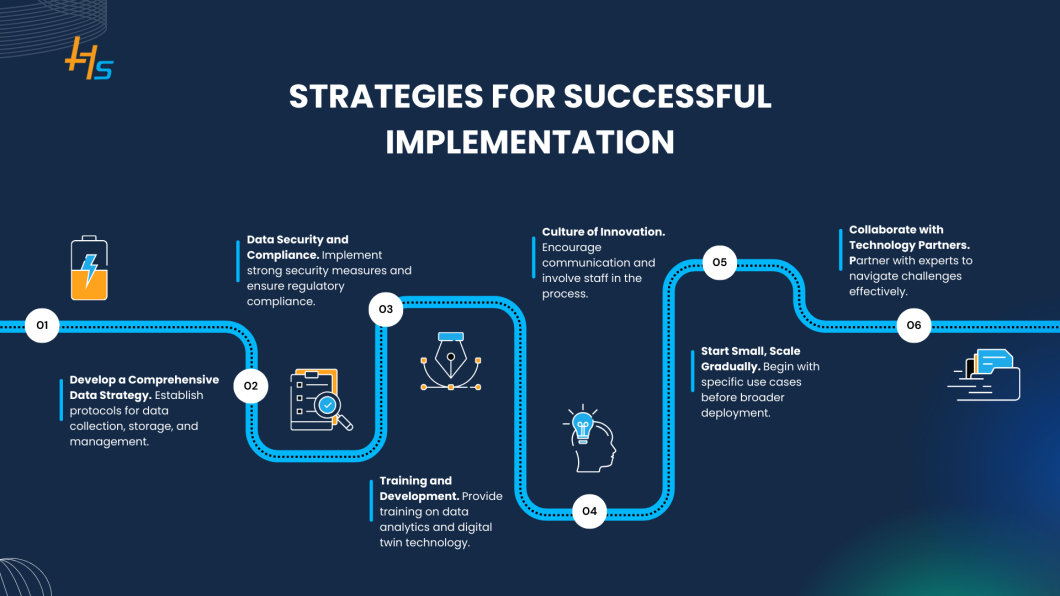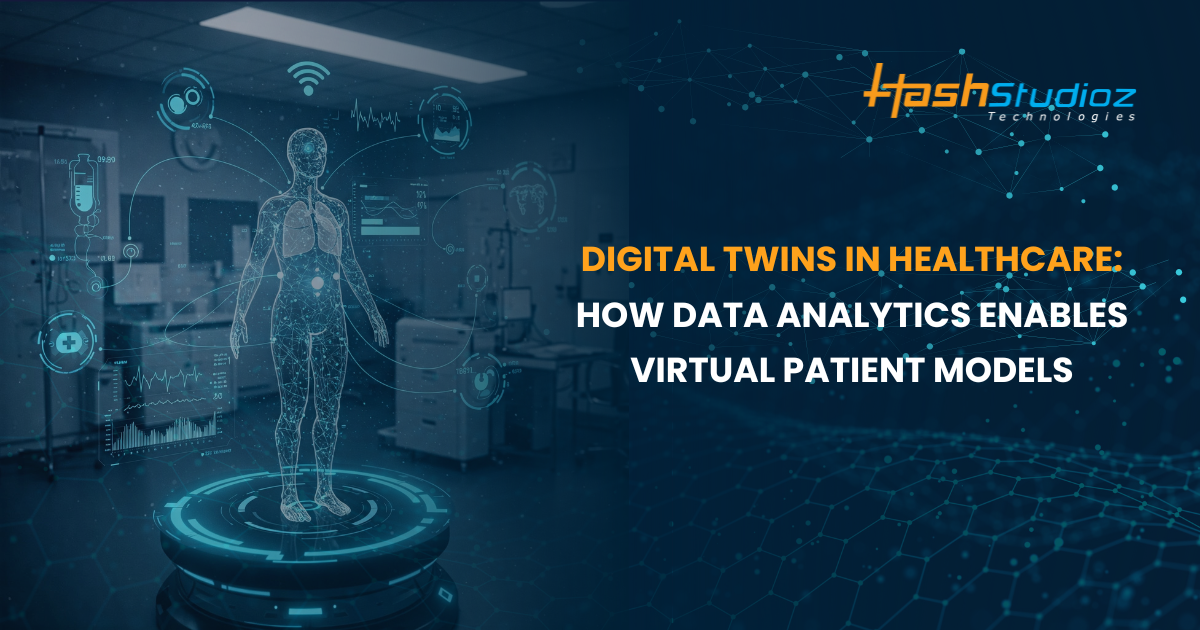The healthcare industry is undergoing a transformative shift with the introduction of digital twins, which create virtual replicas of patients to enhance personalized care. This technology enables real-time monitoring and predictive analytics, leading to improved patient outcomes.
- 75% of healthcare executives believe digital twins in Healthcare will enhance patient care.
- 60% of providers are exploring digital twins for chronic disease management.
- The digital twin market in healthcare is projected to reach $3.5 billion by 2025.
- Over 50% of organizations cite data integration as a major implementation barrier.
In this blog, we will explore the concept of digital twins, their applications in healthcare, and effective strategies for successful implementation. Join us as we uncover how this innovative technology is shaping the future of healthcare delivery.
Table of Contents
- The Dawn of Personalized Healthcare with Digital Twins
- Understanding Digital Twins: A Virtual Mirror of Patient Health
- The Role of Data Analytics: Powering the Digital Twin Engine
- Real-World Applications: Transforming Healthcare Delivery
- Enhancing Efficiency and Patient Care
- Overcoming Implementation Challenges
- Strategies for Successful Implementation
- The Future of Digital Twins in Healthcare
- Partner with HashStudioz for Advanced Data Analytics Solutions
- Conclusion: Shaping the Future Digital Twins in Healthcare
The Dawn of Personalized Healthcare with Digital Twins
Healthcare is constantly evolving, with innovation reshaping how medical professionals deliver care. One of the most exciting developments is the emergence of Digital Twins in healthcare. These dynamic, virtual representations of individual patients, powered by advanced data analytics, are poised to revolutionize diagnostics, treatment, and patient management. By harnessing real-time data and sophisticated modeling, healthcare providers can create highly detailed virtual replicas. As a result, they can simulate patient conditions, predict potential outcomes, and personalize treatment plans with unprecedented precision.
Understanding Digital Twins: A Virtual Mirror of Patient Health
Digital Twins in healthcare is more than just a static digital record. It’s a dynamic, evolving virtual representation of a patient, encompassing their physical body, current health status, medical history, and even lifestyle factors. These virtual models are constructed using a rich tapestry of data, including medical imaging (X-rays, MRIs, CT scans), real-time data streams from wearable sensors and connected medical devices, comprehensive electronic health records (EHRs), and increasingly, genetic information. This multifaceted data input allows Digital Twins in healthcare to offer real-time, personalized insights, empowering healthcare professionals to gain a deeper, more nuanced understanding of each patient’s unique needs.
The Role of Data Analytics: Powering the Digital Twin Engine
jThe true potential of Digital Twins in healthcare is unlocked by the sophisticated data analytics that drive them. By analyzing vast quantities of data, healthcare providers can simulate various treatment scenarios and predict patient responses with greater accuracy. Here’s a closer look at how data analytics fuels the Digital Twin revolution:

Real-Time Data Integration
Wearable sensors, implantable devices, and other connected technologies continuously collect and transmit real-time patient data. This constant flow of information seamlessly integrates into the Digital Twin model, enabling healthcare providers to track a patient’s health status dynamically, in real time.
Predictive Modeling
Advanced analytics algorithms analyze patient data over time, identifying patterns and predicting potential health outcomes. These predictive capabilities are invaluable, enabling doctors to make more informed decisions. As a result, they can anticipate potential complications and develop highly personalized treatment plans tailored to each patient’s unique circumstances.
Simulation of Treatment Scenarios
Healthcare data analytics service providers run virtual simulations, predicting how a patient might respond to different treatments. This allows for the virtual “testing” of various approaches without any actual risk to the patient, significantly improving treatment optimization and reducing the likelihood of adverse reactions.
Real-World Applications: Transforming Healthcare Delivery
The applications of Digital Twins in Healthcare are vast and rapidly expanding across various medical specialties:
Personalized Treatment
Digital Twins in healthcare facilitate the creation of highly individualized treatment plans. By modeling a patient’s specific health data, doctors can select interventions with a higher probability of success, guided by simulations and predictive analytics. This personalized approach is particularly transformative in fields like oncology, where treatment effectiveness can vary significantly between individuals.
Chronic Disease Management
For patients managing chronic conditions, Digital Twins offer continuous health monitoring and early detection of potential flare-ups or complications.
Real-time insights into disease progression allow healthcare providers to proactively adjust medications, lifestyle recommendations, and treatment plans. Consequently, this leads to improved long-term health outcomes and a higher quality of life. Moreover, AI analytics can identify at-risk patients, enabling timely interventions that prevent complications. Furthermore, continuous monitoring ensures quick responses to any changes, optimizing overall treatment strategies.
Surgical Planning
Before complex surgical procedures, surgeons can leverage Digital Twins in healthcare to simulate the operation in a virtual environment. This allows them to explore the optimal surgical approach, anticipate potential challenges, and refine their techniques. Done on the basis of patient’s specific anatomy and medical history. This reduces the risk of complications during surgery and increases the chances of successful outcomes.
Enhancing Efficiency and Patient Care
Digital Twins in Healthcare contribute to significant improvements in both patient care and operational efficiency within healthcare institutions:
Enhanced Patient Monitoring
Digital twins in healthcare provide a comprehensive view of patient health by integrating real-time data from various sources. This technology enables healthcare providers to continuously monitor vital signs, ensuring that any deviations from baseline are promptly detected and addressed. As a result, faster interventions can be made, potentially preventing the escalation of adverse health vents. Furthermore, by utilizing predictive analytics and machine learning, digital twins can identify health risks early, allowing for proactive care and improved patient outcomes. This innovative approach not only enhances patient safety but also streamlines clinical operations, ultimately driving better healthcare delivery.
Resource Optimization
By leveraging Digital Twins in healthcare to predict and manage patient flow more effectively, healthcare providers can optimize the allocation of valuable resources. Hospitals and clinics can efficiently distribute staff, medical equipment, and bed availability, reducing operational costs and improving overall patient satisfaction.
Overcoming Implementation Challenges
While the potential of Digital Twins in healthcare is immense, their widespread adoption faces some key challenges:
Data Integration Issues
One of the primary technical challenges in implementing digital twins in healthcare is the integration of diverse data sources. Healthcare systems often use multiple platforms for electronic health records (EHRs), medical devices, and patient monitoring systems. To create accurate digital twins, it is essential to ensure seamless data flow between these systems. However, inconsistent data formats and standards complicate this integration process, leading to incomplete or inaccurate representations of patient health. Furthermore, achieving interoperability among various systems is crucial for effective communication and comprehensive utilization of digital twins.
Data Privacy and Security Concerns
The sensitive nature of healthcare data raises significant privacy and security concerns. Organizations must comply with regulations such as HIPAA (Health Insurance Portability and Accountability Act) to protect patient information. Implementing robust security measures while ensuring data accessibility for real-time analytics can be a delicate balance.
Lack of Skilled Workforce
The successful deployment of digital twin technology requires a skilled workforce proficient in data analytics, machine learning, and healthcare informatics. However, there is often a shortage of professionals with the necessary expertise, making it challenging for organizations to build effective teams for implementation.
Resistance to Change
Healthcare professionals may be hesitant to adopt new technologies due to concerns about workflow disruptions or the learning curve associated with new systems. This resistance can hinder the successful implementation of digital twins in healthcare, as buy-in from staff is essential for effective utilization.
Strategies for Successful Implementation

To successfully implement a comprehensive data strategy in healthcare, organizations must focus on several key areas that enhance data integration, security, and technological advancement.
Develop a Comprehensive Data Strategy
Healthcare organizations should establish a holistic data strategy that outlines the processes for collecting, storing, and sharing data across various systems. Utilizing standardized data formats and protocols is essential for seamless integration, ensuring that digital twins in healthcare are constructed from accurate and complete datasets. Moreover, this strategy should align with business objectives to effectively leverage healthcare data for strategic insights.
Prioritize Data Security and Compliance
Strong data security measures are critical for safeguarding patient information. Healthcare organizations must invest in encryption, access controls, and conduct regular security audits to protect sensitive data. Staying informed about regulatory requirements, such as HIPAA compliance, will help mitigate legal risks associated with data breaches.
Invest in Training and Development
To bridge the skills gap in healthcare technology, organizations should invest in comprehensive training programs for staff. Educating employees on data analytics, digital twin technology, and its applications will empower them to utilize these tools effectively, enhancing overall operational efficiency.
Foster a Culture of Innovation
Encouraging an organizational culture that embraces innovation is vital for successful implementation. Leadership should communicate the benefits of adopting digital twins in healthcare and actively involve staff in the process. Gathering feedback and addressing concerns fosters ownership and collaboration among team members.
Start Small and Scale Gradually
Organizations can implement digital twins by targeting specific departments or use cases, such as chronic disease management or surgical planning. This phased approach allows for effective testing and refinement before organization-wide scaling, ensuring a smoother transition and minimizing disruptions. Additionally, focusing on specific areas facilitates a manageable integration process, leading to better outcomes and increased stakeholder buy-in. Ultimately, this strategy enhances the effectiveness of digital twin technology and supports the organization’s digital transformation goals.
Collaborate with Technology Partners
Partnering with specialized technology providers can offer valuable expertise and resources necessary for navigating technical challenges. These collaborations can accelerate the implementation of digital twin solutions, ensuring that healthcare organizations can effectively leverage technology to improve patient outcomes.
By focusing on these strategies—developing a robust data strategy, prioritizing security, investing in training, fostering innovation, starting small, and collaborating with experts—healthcare organizations can successfully implement advanced technologies that enhance patient care and operational efficiency.
The Future of Digital Twins in Healthcare
The future of Digital Twins in healthcare is incredibly bright. As technology continues to advance, these virtual models will become even more sophisticated and accurate, empowering healthcare providers to deliver increasingly personalized and effective care. The integration of artificial intelligence (AI) and machine learning (ML) will further enhance predictive analytics, leading to more informed decision-making and improved treatment outcomes. As healthcare increasingly focuses on proactive and preventative care, Digital Twins in healthcare will play a crucial role in identifying health risks early on, enabling timely interventions and promoting wellness.
Partner with HashStudioz for Advanced Data Analytics Solutions
HashStudioz is a pioneer in leveraging Data Analytics and Digital Twin technology to revolutionize healthcare. We specialize in:
- Real-Time Data Integration from wearable devices and medical sensors to create dynamic patient models.
- Predictive Analytics to anticipate health outcomes, optimize treatments, and enhance patient care.
- Simulation of Treatment Scenarios for risk-free testing and improved decision-making.
With a focus on patient data security, privacy (GDPR, HIPAA), and tailored healthcare solutions, we help healthcare providers deliver personalized care, minimize risks, and drive innovation. Partner with HashStudioz to transform patient care through data-driven Digital Twin models.

Conclusion: Shaping the Future Digital Twins in Healthcare
Digital Twins represent a paradigm shift in healthcare, offering a powerful new approach to patient care. By leveraging data-driven insights and personalized modeling, these virtual replicas have the potential to transform diagnostics, treatment planning, and overall patient management. While challenges remain, the future of Digital Twins in healthcare is filled with promise. As technology continues to evolve and mature, their impact on patient care will only grow, leading to improved outcomes, enhanced efficiency, and a more personalized and proactive approach to healthcare.

